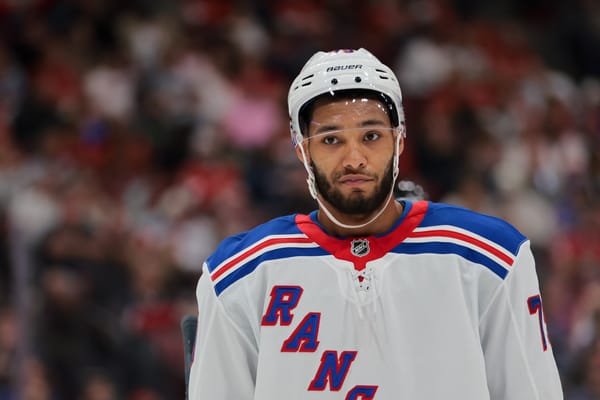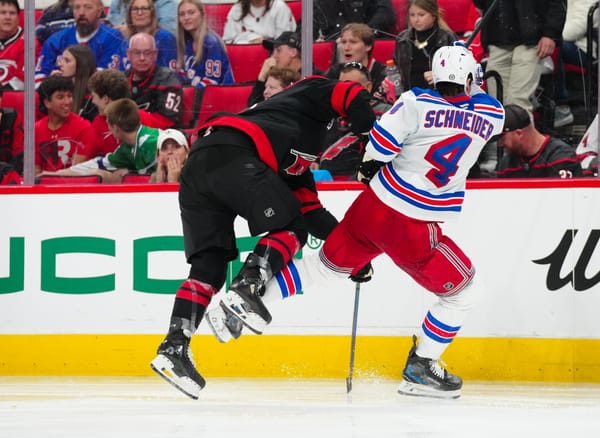What The Rangers Are (Probably) Getting in Alexis Lafreniere
A team loaded with young wingers is poised to add its best yet.
If 2020 has proven anything, it’s that nothing should be taken for granted. Rangers General Manager Jeff Gorton would not verbally commit last night to taking projected top pick Alexis Lafreniere, and with two months until the draft he wouldn’t be doing his job if he didn’t do his due diligence on other players and potential trade options.
But it would be one of the most shocking moments in the history of the draft if the Rangers passed on the productive winger first overall on October 9.
The last first-overall pick to come from Rimouski Oceanic was Sidney Crosby in 2005. As such, comparisons between him and Lafreniere are inevitable. Any discussion of Lafreniere matching Crosby’s career should be brought to an immediate and screeching halt. Still, there are similarities in playing style worth referencing.
Like Crosby, Lafreniere’s biggest asset is his brain. He thinks on the ice at an elite level. Hockey remains a highly rigid, structured game, but coaches are slowly allowing for more unorthodox approaches and roaming from position, particularly for an incredibly cerebral player who can be trusted to make his own judgments, such as Lafreniere. The result is a left winger who in many ways serves as a pseudo-center, who — once the faceoff occurs — dictates play from the outside and often will cut inside to take on more responsibility left to the pivot than the winger.
Lafreniere’s vision and hockey sense are elite. Those are broad — if not vague — terms, so let’s break down some different examples of what that means in his case.
He doesn’t typically offer outlet support or fly the zone like wingers typically do on breakouts. Rather, he comes all the way back to collect the puck and serves as point guard.
And look at that precision passing ability. The average player floating saucers across the neutral zone or passing in the middle lane through the opposition’s sticks is typically the source of nightmares for a coach, and Lafreniere will have to tighten up a bit against higher levels of competition. But he is one of the few players who can get away with it, though, because he has the rare ability to read the ice and the hands to thread needles.
He’ll pick apart a defense to set up high-percentage shots in the offensive zone, too. Here’s an example of him making a play across the slot line, which I’m sure will make Steve Valiquette happy.
These types of plays would be encouraging for an average prospect, but for Lafreniere it’s the boring part. The thing about NHL players is that they’re all ridiculously good. What I mean by that is, even the most mediocre NHL players can stand in a practice rink and hit targets with jaw-dropping precision. What makes the elite playmakers elite is their ability to make plays in motion and disguise their intentions.
In this example, it’s not enough to say that Lafreniere accurately passes the puck; what creates the scoring chance is that he keeps his feet moving and can make those plays while doing so. He doesn’t lose any speed while changing his body position, both in terms of his skating as well as the quickness with which he gets off those passes.
His specialty is deceit. Like a pitcher who has the same release on a fastball and changeup, there’s no “tell” in his game. His body movements are so quick and efficient, he seemingly has eyes in the back of his head, which is a disastrous combination for defenses. The constant movement means new lanes open up all over the ice, and he has the vision to see them out off the corner of his eye and the hands to then execute the pass before the defense can read the play and adjust (#11 in these clips).
His stick handling adds yet another dimension. His ability to anticipate openings combined with incredible shiftiness means he can expose defensemen who take bad angles in defense or who mistime attempts to aggressively defend him.
As a scorer, can he keep up with the likes of Auston Matthews and Steven Stamkos? Not even close. Is he nonetheless a player who could and should score 30-plus in his prime? Absolutely. Lafreniere is not going to rip blistering shots past goalies. Nonetheless, his scoring comes in a variety of ways.
He has enough shooting prowess to keep the opposition honest from the top of the circles. Like Crosby, what he lacks in velocity in his shot he makes up for with that same deception and precision. At one moment he’s nonchalantly stick handling the puck, and the next, he’s effortlessly flicking his wrists and floating the puck top shelf before anyone can react. He uses the same types of body fakes on his passes to open up lanes for him to shoot or carry the puck into shooting positions.
The last thing I’ll highlight is Lafreniere’s movement off the puck. For all of the highlight reel plays, Lafreniere gets on the scoresheet often just by ending up in the right place at the right time around the net. What appear to be easy goals are only such because of the thinking and effort he put in when the puck arrived. He’s not afraid of the middle of the ice and he’ll drive to the net and battle through traffic to get into scoring positions and find loose pucks around the crease. That he is a skill player does not mean is solely a “perimeter” or “east-west” player.
My friend Jesse Marshall of The Athletic highlighted one great example of this.
Lots of fancy Lafreniere highlights but my favorites are the ones where he's just smarter than everyone else. Like in this clip, goes from puck-carrier to goal-scorer with a strong middle drive that nestles him in behind the defense. They don't even know he's there. pic.twitter.com/AginHa02by
— Jesse Marshall (@jmarshfof) August 10, 2020
Here are two more of my own examples.
In both clips, the puck is on the opposite side of the offensive zone and the play is seemingly innocuous, with no apparent danger. But Lafreniere keeps his feet moving, anticipates a vulnerability developing in the slot, and loses his man.
When I compare Lafreniere to Crosby stylistically, what I mean is the diversity of their offensive games. Think about what Crosby’s real physical strengths are. Does he have a brilliant shot, like Alex Ovechkin or Matthews? No. Is he an elite skater, like McDavid or MacKinnon? No. Does he have overwhelming power and strength like Gordie Howe or Jaromir Jagr? Not at all.
Crosby’s strength is that everything is a strength and he has the brain to make the most of each. The same is generally true for Lafreniere. Some players are dominant because they have a few go-to moves that the opposition is powerless to stop. In the case of Lafreniere, it’s that he can beat you so many different ways. He controls the tempo of the game with the puck on his stick. He makes incredible plays in space, and if there is no space then he’ll find a way to create it. Once he moves the puck, he keeps his feet moving and finds the next spot to contribute. He’s never out of the play and he’s always a threat no matter the situation.
With all that said, what are Lafreniere’s perceived weaknesses? In answering this question, one must first understand that we’re speaking relatively. Compared to the average NHLer, Lafreniere is good at everything. Any criticisms of his game are relative to the expectations of a first-overall pick.
Skating is the “worst” part of his game. His agility is fairly good but he lacks explosiveness. It was a legitimate problem a year or two ago. He’s since improved in that regard to the point that it’s now average at worst by NHL standards. He developed credible separation speed at the junior level, but will that hold up in the NHL? Not likely, though he is still just 18 years old and could improve plenty. It’s not a hindrance, but skating is probably the best reason for why Lafreniere has not quite reached the tier of generational prospects like Crosby or McDavid were at the same age.
I have also heard some criticisms of his defensive game. I don’t know if I personally buy into that. Like most teenagers in juniors, he has work to do and — against lower levels of competition — his individual ability probably allows him some runway for tactical missteps.
His effort can’t be faulted. He forechecks with enthusiasm and he creates plenty of offense picking off passes. The same instincts that lead to him creating offensive also serve him well in anticipating what’s about to unfold defensively. He gets his stick in lanes and disrupts plays.
Although I don’t doubt some will rush to stereotype him as “soft,” it’s really not the case at all. Lafreniere is as physical as he needs to be in order to be effective. As previously mentioned, he’ll drive the middle lane on offense and fight for pucks around the crease. At the World Juniors, he set the tempo vs USA in their group stage match with some pretty big hits.
Maybe it won’t show immediately as he transitions from dominating juniors to playing in the NHL, but as he matures I believe he’s going to be a 200-foot player who could possibly even contribute on the penalty kill and be deployed to defend leads.
Lafreniere likely falls short Crosby and McDavid as surefire Hall-of-Famers before they even reached the NHL, but he’s one tier below that. Certainly and demonstrably above both Jack Hughes and Kaapo Kakko in last year’s draft, and that’s no criticism of those two. Lafreniere is the best player to come through Canadian Juniors since McDavid, and if there’s any concern about the level of competition then just look to his 10 points in five World Juniors games for Canada this past Winter; good enough to lead the entire tournament by points-per-game. If Lafreniere develops as expected — and there isn’t much reason to doubt he will — the Rangers will have a legitimate superstar winger who could challenge for individual accolades and be the best forward on a perennial Stanley Cup contender.
That ability is why Lafreniere is the top player on every draft board, and it’s why the Rangers, even as stacked as they are on wing, and as desperate as they are for centers and defensemen, will in any reasonable scenario take him without the slightest hesitation.




